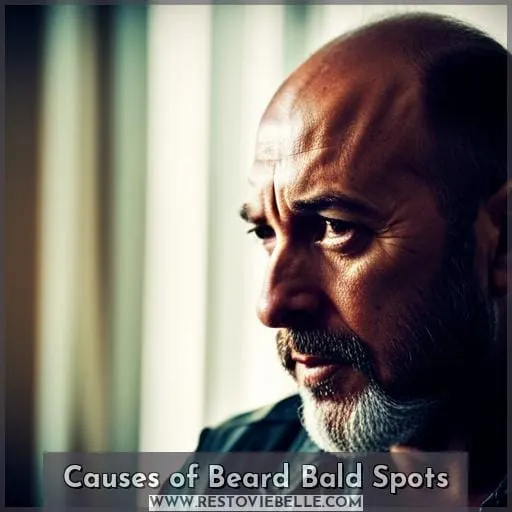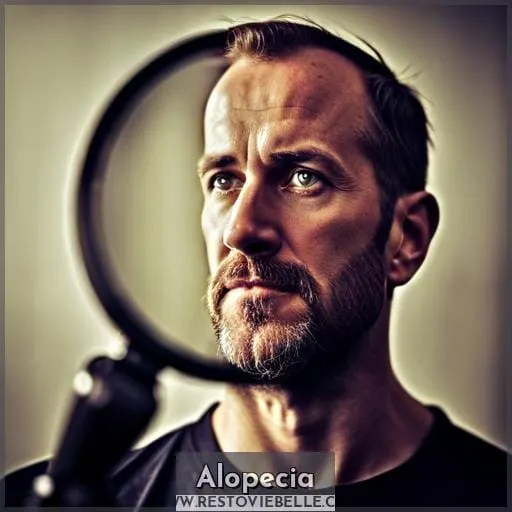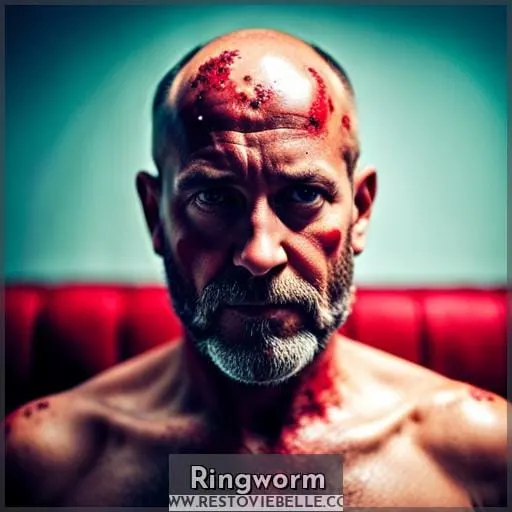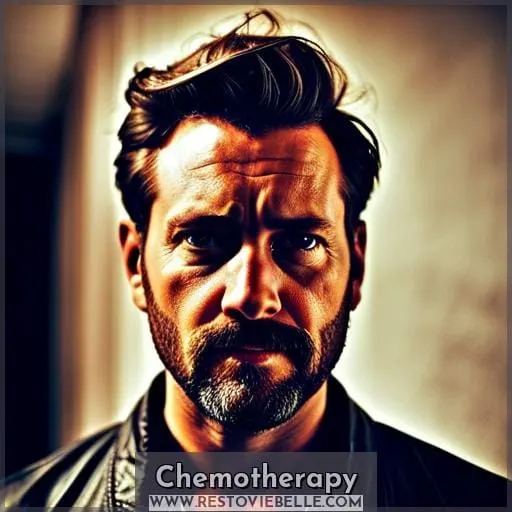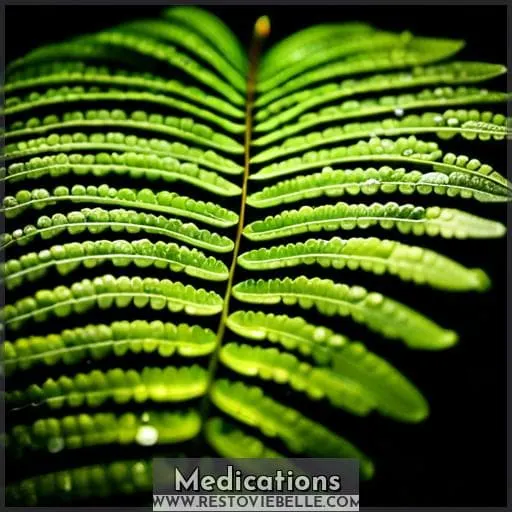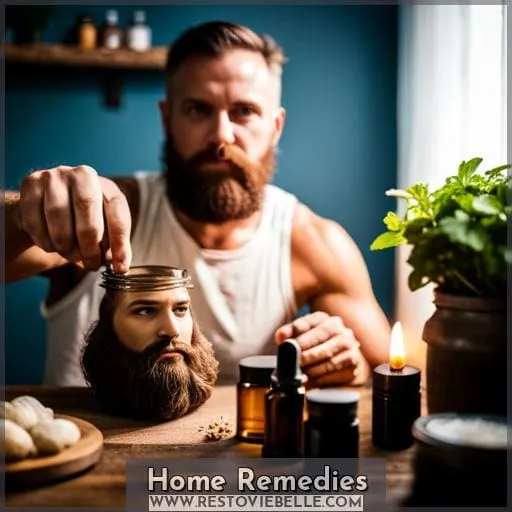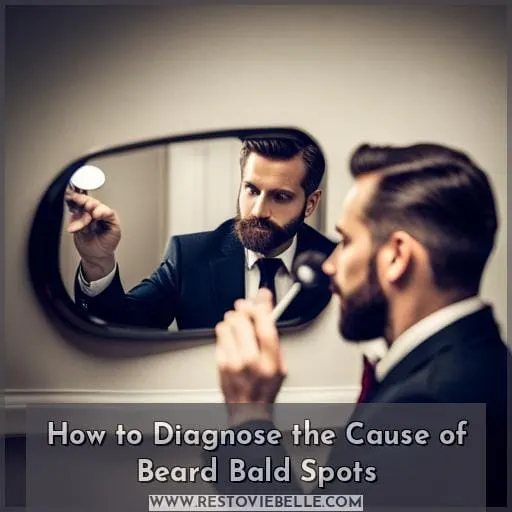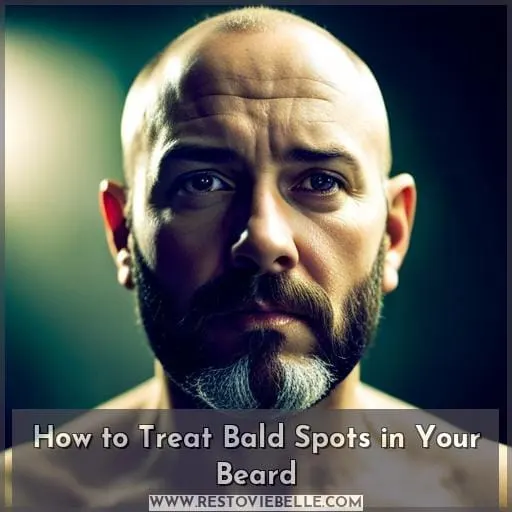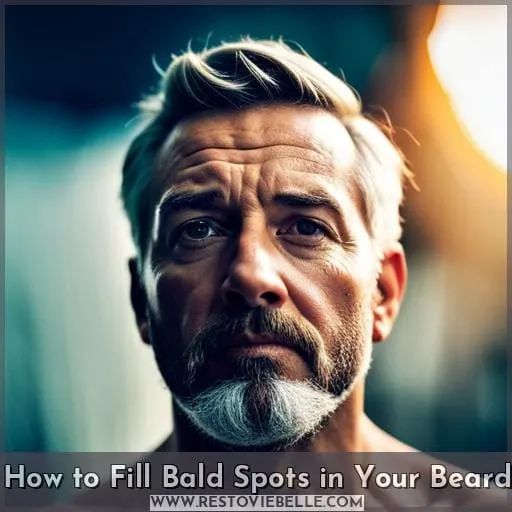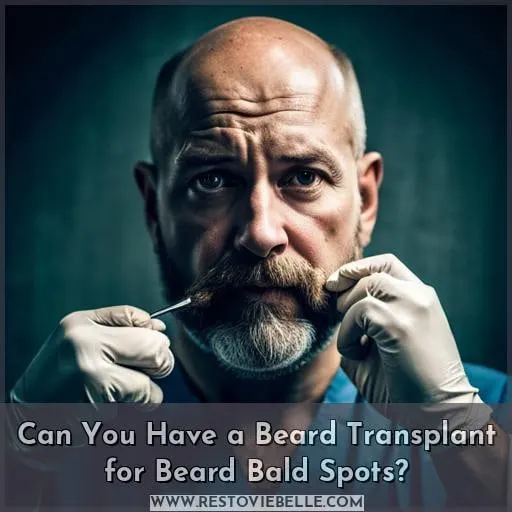This site is supported by our readers. We may earn a commission, at no cost to you, if you purchase through links.
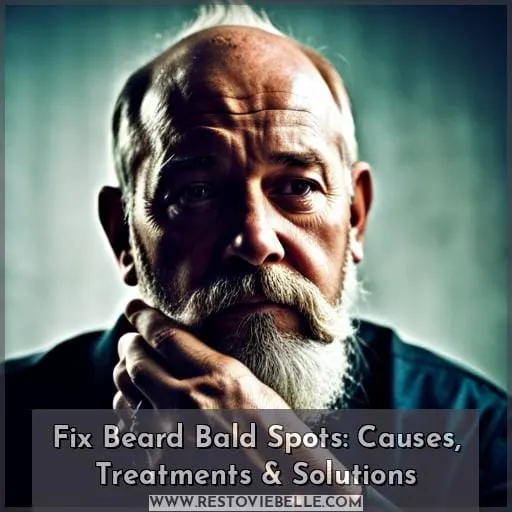 You know that feeling when you look in the mirror and see a spot of baldness where your beard once was? It’s like being reminded of something slipping away from you, something that made you feel powerful and confident.
You know that feeling when you look in the mirror and see a spot of baldness where your beard once was? It’s like being reminded of something slipping away from you, something that made you feel powerful and confident.
But don’t worry – all hope is not lost! There are ways to fix bald spots on beards, some more permanent than others.
In this article, we will explore the causes behind these patches as well as home remedies, treatments, and other solutions for fixing them so that your beard can regain its former glory.
Table Of Contents
- Key Takeaways
- Causes of Beard Bald Spots
- Alopecia
- Ringworm
- Chemotherapy
- Medications
- Home Remedies
- How to Diagnose the Cause of Beard Bald Spots
- How to Treat Bald Spots in Your Beard
- How to Fill Bald Spots in Your Beard
- Can You Have a Beard Transplant for Beard Bald Spots?
- Frequently Asked Questions (FAQs)
- Conclusion
Key Takeaways
- Proper diagnosis and consultation with professionals are essential for effective treatment of bald spots on the beard.
- Lifestyle factors such as diet and sleep quality can impact beard health and growth.
- Natural remedies like garlic gel, zinc supplements, and biotin can help improve beard growth.
- Instant solutions like hair fibers and thickening sprays can be used to cover up and temporarily fix bald spots on the beard.
Causes of Beard Bald Spots
It’s important to understand the various causes of beard bald spots, such as alopecia, ringworm, and chemotherapy-induced hair loss, in order to properly assess and treat them so you can restore your confidence.
Alopecia is an autoimmune condition that attacks the hair follicles, resulting in circular bald patches known as alopecia barbae.
Ringworm is a fungal infection that may cause red or scaly skin with itchy rashes and patchy hair loss due to skin infections.
Chemotherapy-induced alopecia (CIA) occurs when cancer treatments damage the body’s cells, leading to temporary baldness on areas where facial hair grows like beards.
Hormonal imbalance caused by DHT testosterone levels may lead to sparse growth, while sleep deprivation affects overall health, causing poor growth too.
Vitamin E supplements have limited evidence of being effective against treating certain types of alopecias, while micropigmentation has been found suitable for cases of Alopecia Barbae. Though it will depend upon each individual case whether these remedies are applicable or not – seeking medical advice would provide guidance on this matter.
Alopecia
If you have noticed bald patches in your beard, it could be a sign of alopecia barbae. Other possible causes include hormone-related issues, sleep deprivation, certain medications, and infections. It is important to identify the cause before attempting to fix any beard bald spots so that the appropriate treatment can be administered.
Alopecia Barbae
Alopecia barbae is an autoimmune condition that results in bald patches on your facial hair. Common symptoms include indented fingernails, itchy and red skin, as well as a circular rash with itchiness and hair loss.
Diagnosis involves a physical exam to inspect the beard area, followed by taking samples of the scalp or skin for biopsy or microscopy examination. Treatment often includes steroid creams, injections, and tablets, but it can also involve over-the-counter antifungal products if tinea barbae is the cause.
Be sure to consult with a doctor before using any form of medication, such as vitamin E supplements or minoxidil, for alopecia areata treatment options, as they may have unwanted side effects on the body’s overall health!
Beard grooming techniques, like proper care for the scalp and styling, can help reduce the appearance of bald spots while addressing underlying causes that trigger alopecia.
Other Causes
Other causes of beard bald spots can include hormone-related issues, infections, and sleep deprivation. Hormone-related baldness may be treated with minoxidil or PRP therapy to stimulate hair growth. Sleep deprivation can cause stress, which in turn affects testosterone levels, leading to sparse growth.
Getting enough rest is key! Vitamin E supplements have been known to help alopecia areata patients, but caution should be taken when using them for other conditions as they could potentially worsen the symptoms.
Zinc supplements may also help boost cell production in the scalp, while low laser light treatment has been successful at treating some cases of circular bald patches on the beard area caused by alopecia barbae due to its ability to increase blood flow and decrease inflammation.
Platelet-rich plasma therapy is another popular option that works by injecting platelets containing numerous proteins into affected areas for healing purposes. However, this technique should only be used after consulting a doctor about your individual case first.
Ringworm
Are you having trouble with a bald spot on your beard? It could be caused by the fungal infection, ringworm. Ringworm, also known as tinea barbae, is characterized by circular patches of red or scaly skin that can lead to hair loss in the affected area.
Symptoms include itchiness, irritation, and scarring alopecia, which may affect your confidence.
To treat this condition effectively, it’s important to make lifestyle changes such as improving diet quality and getting adequate sleep. It is also important to address any underlying hormone imbalances that might be contributing factors for beard hair loss.
For more severe cases, it’s important to seek medical advice from a doctor who specializes in treating alopecia barbae symptoms.
Chemotherapy
Chemotherapy can cause temporary hair loss, including in the beard area, and may warrant shaving prior to treatment. To reduce chemotherapy-induced alopecia (CIA), it is important to maintain good scalp health.
This includes reducing stress levels and making sure vitamin deficiencies are addressed. Additionally, garlic has been seen as a potential natural remedy for boosting immune system strength, which could be beneficial during cancer treatments such as radiation therapy.
Here’s what you need to do:
- Use zinc supplements: Zinc helps support healthy hair growth by aiding collagen production for healthier follicles.
- Garlic gel: Garlic is known for its anti-inflammatory properties that can help protect against CIA damage.
- Avoid any other medication or lifestyle changes without consulting your doctor first. This will minimize the risk of further damage from chemotherapy-induced hair loss.
Understanding the causes of bald spots on beards and taking steps towards preventing them are essential parts of maintaining an attractive-looking beard while going through cancer therapies like chemotherapy.
Taking actionable steps such as using zinc supplements or garlic gel will go a long way in helping manage both physical symptoms associated with CIA and emotional impacts caused by sudden face-covering hair loss.
Medications
Medications such as corticosteroids, minoxidil, DPCP, and anthralin can be a godsend in treating bald spots on your beard. Steroid creams are an effective way to reduce inflammation caused by alopecia barbae.
Minoxidil injections can help stimulate the growth of new hair follicles, while PRP therapy helps increase blood flow to affected areas for improved growth potential.
If you’re looking for more instant results, thickening sprays or hair fibers may do the trick. Biotin supplements have been known to improve the overall health of body hair, including facial ones, but should only be taken after consulting with a doctor due to possible side effects from over-supplementation when it comes to medications and hair loss-related problems like alopecia causes and treatment is concerned.
There are also natural remedies such as garlic gel or Viviscal that could help with beard growth if used regularly – just make sure they don’t contain any ingredients that could irritate your skin since facial skin is especially sensitive compared to other parts of the body!
With these treatments combined together, along with proper sleep hygiene and a balanced diet, success rates will definitely go up in terms of reversing any signs of baldness on your face.
| —————– | ———————— | Steroid Creams | Minoxidil Injections | |
|---|---|---|---|---|
| Bald Spot Prevention | PRP Therapy & Hair Fibers | |||
| —————– | ———————— | |||
| Thickening Sprays & Biotin Supplements | ||||
| —————– | ———————— |
Home Remedies
Home remedies such as topical garlic gel, Viviscal supplements, and zinc can help promote the growth of a healthy beard.
Other solutions for bald spots include the use of vitamin E oil on the scalp or laser therapy treatments that stimulate hair follicle growth.
For those dealing with an autoimmune response causing facial hair loss, many have found success in treating their patchy beards by using DHT blockers or products containing anthralin.
Additionally, some natural methods for tackling baldness are available too. These range from simple scalp massages to avoid itchiness all the way up to full-fledged homeopathic treatments designed specifically for beard care and hair loss management.
While there is no one-size-fits-all solution when it comes to treating bald spots on your face and head, it’s important not to forget about lifestyle factors like diet choice and sleep habits, which can also play a role in restoring lost hairs!
With proper attention paid towards both medical treatment options as well as everyday personal ones, you should be able to find yourself back on track towards having that thick, luxurious mane once more!
How to Diagnose the Cause of Beard Bald Spots
To accurately diagnose the cause of your beard bald spots, you should consult a medical professional for an assessment and recommended treatment. However, understanding possible triggers or lifestyle factors can help you work towards restoring your confidence in your appearance.
- Skin biopsy and blood tests may be used to measure DHT levels or testosterone levels.
- Vitamin supplements aren’t recommended as they could worsen autoimmune conditions like alopecia areata, which often manifest with hair loss from the scalp and facial hair areas.
- A dermatologist may examine hair follicles to detect any infection causing the bald patches in the beard area, along with other underlying causes such as hormone imbalance if needed.
- To instantly cover up sparse growth on the face, one can use camouflaging products such as colored sprays or fibers. These products blend naturally into existing hairs without leaving any residue behind when washed off later on.
With the correct diagnosis, it’s easier to identify optimal treatments depending on the individual’s condition.
How to Treat Bald Spots in Your Beard
Are you dealing with bald spots in your beard? There are various treatments available to help address patchy beard growth and other causes. From prescription medications to home remedies, there is a range of options that can bring your facial hair back to life.
Treatments for Patchy Beard Growth
You can give your patchy beard the fullness it deserves with treatments such as minoxidil, PRP therapy, and low laser light. Hormone-related bald spots may require a beard transplant to restore growth and coverage.
Vitamin E supplements for alopecia areata should be taken with caution. Treatments also address sleep issues that lead to patchy hair growth, as well as hormonal factors causing sparse areas of facial hair development.
Micropigmentation is an option for those dealing with alopecia barbae or other forms of beard bald spots while determining the suitability of a potential Beard Transplant requires medical examination from qualified professionals in order to decide on proper treatment options.
| Treatment | Suitability |
|---|---|
| Minoxidil | All types |
| PRP Therapy | Hormonal imbalance |
| Low Laser Light | Patchy Hair Growth |
| Vitamin E Supplements (Alopecia Areata) | |
| Sleep Issues | |
| Hormonal Factors | |
| Micropigmentation (Alopecia Barbae) | |
| Beard Transplant | |
| Medical Examination |
The best way forward is consulting experts who understand how best to treat each individual case – seeking advice early will ensure you get maximum benefits from available treatments and maintain healthy facial hair growth going forward.
Treatments for Other Causes
For other causes of patchy beard growth, such as sleep deprivation and infections, it’s wise to try treating the underlying trigger first. Remember, an ounce of prevention is worth a pound of cure! Alternative therapies like vitamin supplements or hormone treatments may help improve hair growth.
Thyroid disease can also cause bald spots in beards, so it’s important to get any underlying medical conditions checked out by your doctor.
Additionally, lifestyle changes should not be overlooked either. Support groups for autoimmune diseases or chemotherapy-induced alopecia are available online, and healthy habits like getting enough sleep and eating a balanced diet are essential for optimal hair health.
Finally, micropigmentation could offer quick results if needed, but do consult with a professional before considering this option.
How to Fill Bald Spots in Your Beard
Taking care of your beard is essential to keeping it looking healthy and full. But sometimes, even with proper care, you may find yourself dealing with bald spots in your beard. These can be caused by a variety of factors like hormones, nutrition deficiencies, or immune system issues.
- Beards & Hormones: If hormone levels are off balance, they can lead to sparse growth that causes bald patches in the beard. Speak with a doctor about hormone therapy as an option for restoring thicker growth in these areas if needed.
- Beard Care: Proper daily grooming practices, such as cleansing and conditioning regularly, will help promote healthier hair follicles. This leads to fuller-looking locks on top of stronger roots overall, allowing any existing patchy spots more coverage when styling them outwards away from thinning areas using combs or brushes.
- Nutrition & Supplements: Eating foods rich in vitamins A (carrots), B7 (biotin), D2 (mushrooms), and E (nuts/seeds). Taking supplements like Viviscal, which contains minerals such as zinc and copper, helps promote stronger strands while preventing loss due to stressors originating from either lifestyle habits or cancer treatments.
No matter what has caused the issue at hand, taking positive steps toward resolving it should always remain a forefront priority! With resources available ranging from various types concerning both conventional methods plus alternative approaches, exploring the best fit route accordingly is well worth the time investment when it comes to reclaiming your mane back to its original glory once again!
Can You Have a Beard Transplant for Beard Bald Spots?
Beard transplants can be a viable solution to restore the appearance of your beard, giving you back the confidence that comes with having a full and healthy-looking facial hair. It is possible to have a transplant even for bald spots caused by alopecia barbae or hormone-related issues.
Hair fibers, low laser light therapy, and micropigmentation are other solutions that may help fill in stubble patches caused by sleep deprivation effects.
With any form of treatment, it will take patience and dedication. However, when done properly, it could result in an improved overall quality of life as well as improving your self-esteem when looking at yourself in the mirror each morning.
When considering treatments such as beard transplants, ensure you do adequate research into options available and find experienced practitioners who understand what’s involved with this type of procedure.
Frequently Asked Questions (FAQs)
What are some lifestyle factors that can aid in beard growth?
To aid in beard growth, focus on lifestyle factors such as a balanced diet, adequate sleep, and avoiding triggers such as infections. Consider treatments such as minoxidil or PRP therapy for hormone-related baldness.
Instant improvements can be achieved with hair fibers or thickening sprays, while micropigmentation is suitable for alopecia barbae cases.
How long does it usually take for a bald spot on the beard to heal?
Healing time for a bald spot on your beard depends on its cause. Alopecia, ringworm, and chemotherapy can all lead to hair loss. Your doctor will diagnose the root of the problem and provide treatment options that could help restore growth in as little as two weeks or take up to several months for more extensive cases.
Are there any natural remedies for beard bald spots?
Yes, there are natural remedies for beard bald spots. Try garlic gel, zinc supplements, or biotin to help restore hair growth. You can also consider low-level laser light therapy or PRP injections for a more permanent solution.
Are there any products that can help disguise a bald spot on the beard?
Yes, products are available to help disguise a bald spot on your beard. Try using hair fibers or thickening sprays for instant improvements, micropigmentation for long-term results, and natural remedies such as garlic gel or biotin if needed.
Be sure to consult a professional before taking any steps towards restoring the fullness of your beard.
Is it possible to prevent beard bald spots?
Yes, you can prevent beard bald spots with a balanced diet and plenty of sleep. Use products such as minoxidil or low-level laser light to aid growth. Consider hormone-related treatments for patchy beards, and beard transplants for long-lasting results.
Conclusion
There are many causes of beard bald spots, from alopecia to chemotherapy to ringworm. Recent studies show that 2 in 100 people suffer from alopecia barbae. Thankfully, there are various treatments available to help treat bald spots in your beard, including hormone-related treatments, at-home remedies, and even beard transplants.
The trick is to first identify the cause of your bald spots and then find the right solution that works for you. Restore your beard and confidence with the right diagnosis and treatment. So if you’re dealing with bald spots in your beard, don’t despair; there are solutions available to help fix your beard bald spots.
